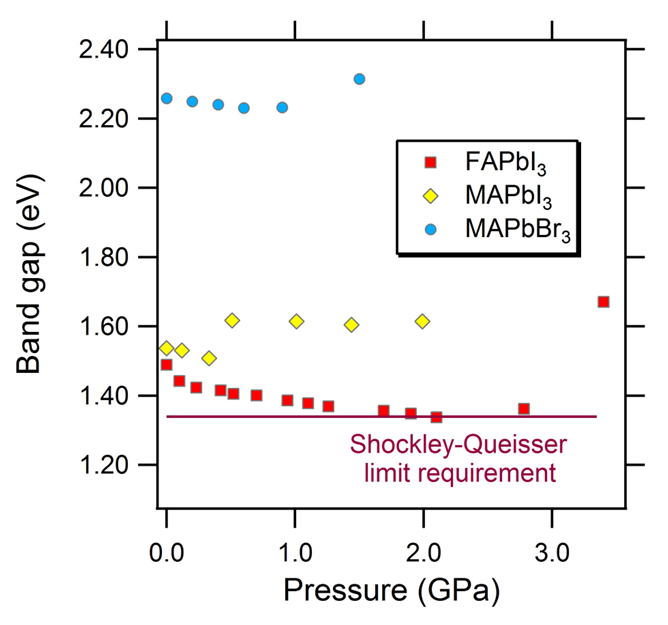Pressure realized bandgap requirement by Shockley-Queisser limit in FAPbI3 - Dr. Gang Liu
DECEMBER 6, 2016
For the first time, scientists have reached the Shockley-Queisser theory optimized bandgap for single-junction solar cells in lead-based perovskites. A new study led by HPSTAR scientists Drs. Gang Liu, report an unprecedentedly tuned bandgap of the Shockley–Queisser limit and double-prolonged carrier lifetime in formamidinium lead triiodide (HC(NH2)2PbI3) in the latest issue of Advanced Functional Materials (DOI: 10.1002/adfm.201604208).
Although an energy conversion efficiency of over 20% has been achieved up to date, further efficiency improvement is only possible if the bandgap is narrowed according to the Shockley-Queisserlimit. Another challenge is maintaining the high-pressure structure and properties of chemical compounds after decompression to stabilise them instandard environments for practical applications.
“We are trying to apply high pressure to tune the band structure of solar cell perovskite”, said Gang. “Given that high-pressure has been proved to be very unique in modulate the electronic structure of energy materials. It’s a clear method without bringing in any impurity”.
 Why FAPbI3? Before the present study, the team also worked on MAPbI3 (CH3NH3PbI3) using the same technique. Gang and co-workers found that bandgap is closed related to the intrinsic lattice structure of solar cell perovskite. To avoid unwanted phase transition, more lattice-stable FAPI3, an analogy to MAPbI3, was chosen for present study.
Why FAPbI3? Before the present study, the team also worked on MAPbI3 (CH3NH3PbI3) using the same technique. Gang and co-workers found that bandgap is closed related to the intrinsic lattice structure of solar cell perovskite. To avoid unwanted phase transition, more lattice-stable FAPI3, an analogy to MAPbI3, was chosen for present study.
The group got a bandgap of 1.33kV, even smaller than the Shockley-Queisser limit-1.34kV by compressing the FAPbI3 up to 2.1 GPa. And the norrowed bandgap did not sacrifice the carrier lifetime but double-prolonged carrier lifetime. Even more surprisingly the tuned bandgap could be partially kept to ambient conditions, indicating the possibility forward further probe and practical usage.
“It is very rare that the structure and properties of chemical compounds under high pressure can be retainable after decompression,” said Gang. “We discover the retainability of the bandgap narrowing upon the release of pressure, paving a practical and clean pathway towards better materials-by-design for more efficient photovoltaic and other semiconductor materials, thus have far-reaching implications for practical applications,” Gang added.
Caption:Pressure-dependent optical bandgapevolutions of FAPbI3 (red), MAPbI3(yellow)and MAPbBr3 (blue).
近年来,太阳能钙钛矿材料由于其在光伏应用中高的能量转换效率和低的制备成本而受到广泛的关注和研究。根据典型的太阳能转换效率极限,也就是所谓的肖克利·奎伊瑟效率极限(Shockley-Queisser Limit),高的太阳能转化效率对应于更小的能带间隙。高压被证明可以有效调节材料的晶体,电子结构从而调控其性质,结合高压技术和先进原位表征手段可以增强我们对该钙钛矿材料结构和性能关系的理解。刘罡等人在之前的高压MAPbI3 (CH3NH3PbI3)研究中发现,太阳能钙钛矿材料的晶格结构与其能带间隙有着紧密的联系。为了得到伴随压力稳定减小的能带间隙,需要有更稳定的晶体结构,与MAPbI3类似的FAPI3是理想的研究对象。通过同样的高压实验,本研究得到了甚至比肖克利·奎伊瑟效率极限(Shockley-Queisser Limit)更小的能带间隙,并且使载流子寿命延长了两倍。令人惊奇的是减小的能带间隙还能在泄压后部分保留,这意味着经过压力处理后的FAPI3具有实际应用的可能。
